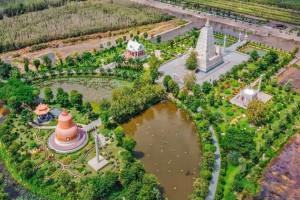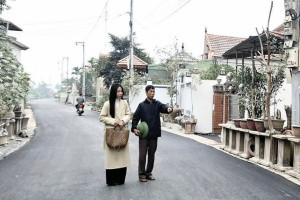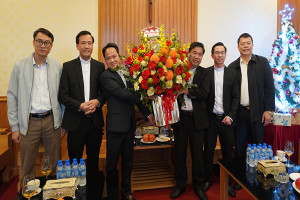
On November 23, four groups of national treasures found in Thang Long ancient citadel are on display at the Hanoi Museum, on the occasion of the Vietnam Cultural Heritage Day for the first time.
The four groups of national treasures, which are being introduced for the first time to the capital city’s residents and visitors, include Co Loa copper drum and ploughshares, belonging to the Dong Son Culture dating back 2,500 - 2,000 years ago, discovered in the heart of Co Loa citadel in Dong Anh District; Thanh Mai bell, dated 798 AD, discovered in Bai Rong, Thanh Mai commune, Thanh Oai District, one out of ten of Vietnam’s Buddhist cultural records in 2006.
The gray glaze ceramic lamp in the 16th century by Dang Huyen Thong, a well-known pottery artist in the Mac dynasty; and a unique Bat Trang worshipping ceramic product by Bat Trang pottery village in the 17th century. These are the national treasures preserved by the Hanoi Museum.
In addition to the four national treasures, the museum also displays a number of images and models of the remaining national treasures discovered in Hanoi, including a simulation of the Buddhist statue of Avalokitesvara Bodhisattva with a thousand eyes in Thanh An temple, Dao Xuyen village, Da Ton commune, Gia Lam district, dating back to the 16th century.
The image of the trinity statues of Amitabha Buddha in Thay pagoda, Sai Son commune, Quoc Oai District, the earliest Amitabha Buddha statue in Vietnam reaching the highest standards of Buddhist design in the early 17th century. The 34 Buddhist statues of the Tay Son dynasty (late 18th century) in Tay Phuong pagoda, Thach Xa commune, Thach That district; and a model of Noi Binh Da communal house in Binh Minh commune, Thanh Oai District.
As a place with a long history and culture, Hanoi is also home to objects and antiques recognised as national treasures by the government. At present, Hanoi is preserving 12 national treasures, stretching from the Dong Son Culture to the Nguyen dynasty.
Among them, four treasures are kept at the Hanoi Museum and eight other treasures are located in the local relics, such as the 82 stone steles at the Temple of Literature and the statue of God Tran Vu - a god from the north who had repeatedly helped the Vietnamese fight off foreign aggression, at the relic of Quan Thanh temple, Quan Thanh Ward, Ba Dinh District.

Co Loa citadel.

In addition to the four national treasures, the museum also displays a number of images and models of the remaining national treasures discovered in Hanoi.

The collection of copper ploughshares discovered along with the bronze drum at Co Loa citadel.

The simulation of the statue of Avalokitesvara Bodhisattva with a thousand eyes in Gia Lam district, dating back to the 16th century, considered to be a magnificent sculpture of the Mac dynasty.

The 17th century Bat Trang worshipping ceramic product displayed at the exhibition.

The 16th century gray glaze lamp by ancient artisan Dang Huyen Thong.

Four groups of national treasures found in Thang Long ancient citadel are on display at the Hanoi Museum, on the occasion of the Vietnam Cultural Heritage Day for the first time.
Source: hanoitimes




